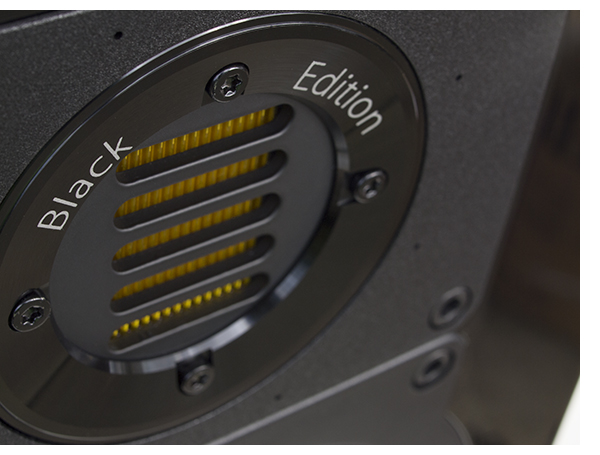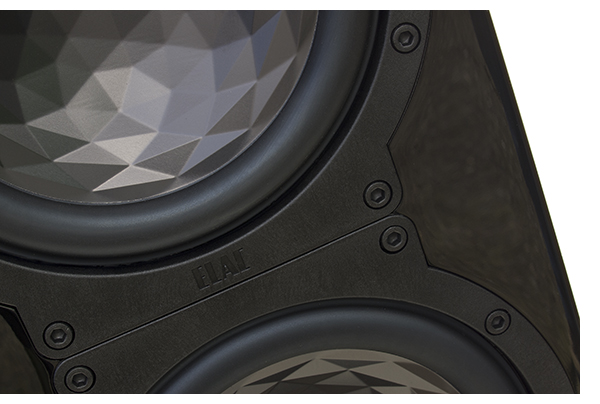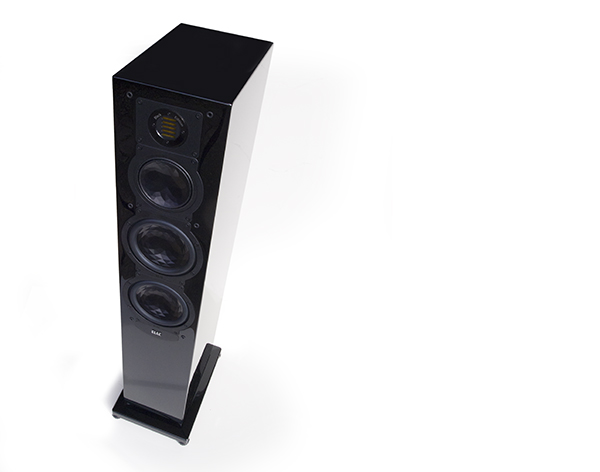Elac’s FS249 Black Edition Loudspeakers Hooked on Teutonic
By Bailey S. Barnard As I unbox the Black Edition versions of ELAC’s FS 249s, I become enthralled with their simplistic, rectangular tower design and sheen black finish.
As I unbox the Black Edition versions of ELAC’s FS 249s, I become enthralled with their simplistic, rectangular tower design and sheen black finish.
Once getting the speakers standing tall (3 feet 8.5 inches tall, to be exact) with their cloth grilles removed, I am intrigued by the sight of the geometric patterns forming their black driver cones and the small, horizontal lines displaying their golden ribbon tweeters. And these ELACs are even more appealing sonically than they are aesthetically.
In fact, after several weeks of listening, I have to double-check the speakers’ price to make sure that Robb Niemann of Rutherford Audio, ELAC’s North American importer, hadn’t forgotten a zero. The FS 249 BEs are priced at $8,000 per pair. Having demoed my fair share of speakers 10 times that value, I am shocked to find that this level of quality can be had for a relatively inexpensive eight grand.
(NOTE: You can skip ahead to “On with the Show” toward the end of this article to read the listening notes, if you’re not interested in company background information and technical nuts and bolts.)
Up to Snuff
I must confess that I conduct the entirety of my review of these speakers with a front end sooner found mated to a pair of much costlier speakers. The Burmester 089 CD player/preamp and 911 stereo power amplifier, priced at about $30,000 each, deliver the goods in my system and push the ELACs to the peak of their performance envelope. The 911’s 350 watts per channel of juice is way more than enough to power these speakers, which have a sensitivity of 90 dB and a nominal impedance of 4 ohms. Users so inclined can bi-amp these speakers.
Having heard this Burmester duo with several five- and six-figure speaker pairs, I will say that the FS 249 BEs are not out of place here. I would have to conduct a careful side-by-side comparison to discern a separation in sound quality that would justify the leap in price to the much costlier speaker I’ve demoed. The ELACs offer a very high value proposition indeed.
Much of this bang-for-your-buck performance can be attributed to the fact that ELAC designs and builds the majority of its speaker components in house. Founded in Kiel, Germany, in 1926, the company—then called Electroacustic GmbH—has a long history of technical innovation to rival that of today’s most highly regarded German manufacturers. The company originally focused on sonar and acoustic signal technologies and, following World War II, shifted its attention to producing a variety of consumer goods, from sewing machine to car parts.
It soon entered the audio realm, first with radios and then with turntables and phono cartridges. The company changed hands a number of times over the years and began designing and building speakers in the 1980s, releasing its first true innovation in 1985, with the omnidirectional 4Pi tweeter, which put the company on the loudspeaker map. Then, in 1993, ELAC purchased a patent for a version of the Air Motion Transformer (AMT), a folded-diaphragm tweeter designed by German electrical engineer Dr. Oskar Heil in 1972 that had gained popularity as an alternative to traditional tweeter designs. And this is where my sonic adoration of the FS 249 BEs begins.
ELAC calls its version of the AMT tweeter the JET (for Jet Emission Tweeter), and the FS 249 BE speakers use the third iteration of this design. The company supplies its JET tweeters to a number of manufacturers and, although those companies remain undisclosed, the JET design is easily recognizable. (It should also be noted that a number of manufacturers have copied this design, but few attain the level of sonic success of the JET.)
This tweeter comprises a folded foil membrane driven by a series of neodymium-magnet rods, forgoing the traditional voice-coil assembly. The materials used for the tweeters, according to ELAC, can withstand operating temperatures of 180 degrees Celsius, whereas others break down at 60 degrees. The result is a reduced loss of electrical-current energy, which is also partly due to the tweeter’s large membrane—which, because of its folded design, has approximately the same surface area as a cone driver with an 8-inch diameter—and its lighting-quick speed. The foil membrane’s low mass requires considerably less movement to generate the same audio response as a dome tweeter. According to ELAC, the JET tweeter is accurate to within 1/100th of a millimeter (which is 10 times thinner than a human hair).
The so-called “crystal cone” diaphragms of the speakers’ driver units are also notable in their design. The FS 249 BEs feature three of these drivers: one 5.5-inch midrange driver below the tweeter, and two 7-inch bass drivers stacked below the midrange. The diaphragm cones of these drivers, which can be found throughout much of the ELAC range, are extremely lightweight and rigid.
The driver cones are constructed from an aluminum-paper composite foil that has been stamped with dozens of little triangles. This design follows the same principal of structural dynamics as Buckminster Fuller’s geodesic spheres—which most people will recognize from the giant Spaceship Earth globe at Walt Disney World’s Epcot center in Orlando, Fla. This design makes the diaphragms extraordinarily rigid, with high “tensional integrity,” as Fuller liked to say, so that they are virtually free from resonance and sonic coloration. The diaphragms are affixed to the driver’s voice coil at both the neck and the base, helping to extend their frequency response by nearly an octave, according to ELAC.
In the Black Edition version of the speakers, the cones are (you guessed it) black instead of the silver used for the standard 240-series speakers. The BE speakers also feature a number of non-aesthetic upgrades, including bigger and better voice coils, refined crossovers and capacitors, and high-grade internal wiring from the signal-transmission wizards at the Dutch firm Van den Hul, which specializes in cabling, phono cartridges and phono preamplifiers.
ELAC is so confident in the construction of its speakers that they come with a full 10-year factory warranty. Knowing all of the technological expertise and high-quality componentry that goes into the FS 249 BEs, I am chomping at the bit to get them set up and singing.
Getting Situated
After several days of positioning the speakers—countless OCD adjustments extend the duration of tweaking into weeks—I find that the speakers perform best in my listening room when they are a little more than 2 feet from the back wall, with the speakers just over 7 feet apart and the listening position about 8 feet from the speakers. Much experimentation results in a 15-degree tow-in providing the optimum imaging in my listening space, which is 12 feet deep and about 16 feet wide, with the right side open to the dining area.
I am quick to admit that my listening space is not ideal—but whose is? Luckily, the FS 249 BEs ship with a pair of rubber plugs to quell the air released from the rear-firing bass ports in the upper portion of the speaker cabinets. (The speakers also have a larger down-firing port in the underside of the cabinets.) I find these plugs useful when listening to music with louder-than-usual bass responses—the low frequencies of some hip-hop, techno, and booming classical recordings can be a little overwhelming in my room. The speakers also come with two little foam disks that can be placed around the tweeters to help control the high-frequency dispersion in smaller rooms. For most music, I prefer the sound without the foam disks, but the tightened dispersion is immediately noticeable when the disks are applied.
On with the Show
The speed and pinpoint imaging of the JET tweeters make complex and detailed music a lot of fun to listen to. And so I turn to Sufjan Stevens’ Come on Feel the Illinoise (Asthmatic Kitty Records, 2005), which is a meticulously made album, with loads of ambient musical details filling up the periphery of the soundstage. The title track begins with a rhythmic piano in the right channel that the full band matches after two bars. The 5/4 time signature in the first part of the song, paired with a smorgasbord of sounds that includes a xylophone panning across the soundstage, make this a difficult song to track, but the ELACs keep up with great success—these tweeters are indeed speedy. And all instruments are given the proper weight, with the imagining of the tweeters accurately placing them across a spacious three-dimensional soundstage that displays ample depth and height. The trumpets enter the mix front and center during the chorus and then, without overpowering Stevens’ airy vocals, the brassy cry begins to rise above the mix, showcasing the vertical capabilities of the JET tweeters.
These tweeters also bring to light the delightful idiosyncrasies of subtler music. At first listen, Alexi Murdoch’s Time without Consequence (Zero Summer Records, 2006) is a very delicate album, with Murdoch’s baritone voice layered softly atop the minimalistic mix. But, at elevated volumes, the depth of the music emerges. On “Beathe,” Murdoch’s palm mutes on his acoustic guitar have substantial precision and weight, while the JET tweeters illuminate the mix’s various background minutia: distant cymbal crashes, slow pulls of a cello, and even what sounds like rhythmic amplified breathing at the right side of the soundstage. This is a seemingly simply mix, but the ELAC speakers reveal the magic lingering beneath the surface.
Similarly, these tweeters provide an abundance of headroom—up to 50 kHz, according to ELAC—which is especially noticeable when reproducing the female vocalists whose albums are common audiophile references. These listeners, however, may find themselves wanting a bit more midrange fullness from such eerily clear recordings. But I find that the speakers deliver vocals from Ella Fitzgerald, Carole King and Adele with all the breadth and gusto I would ever want. My go-to jazz albums from Miles Davis, John Coltrane, and Herbie Hancock also sound as good as they ever have: Dueling solos remain separate but equal, with brass and keys having ample brightness without being overbearing, while strings and drums keep their precision and tightness as they climb down the frequency spectrum.
With most music, I do not find myself wanting for additional bass grunt—the FS 249 BEs dip down as low as 28 Hz, according to ELAC. String- and percussion-heavy classical recordings from Igor Stravinsky and Béla Bartók have the appropriate amount of room-filling boom, giving the illusion of sitting in the middle of a grand concert hall with a 50-foot ceiling.
On “Stinkfist,” the first track on Tool’s Ænema (Zoo Entertainment, 1996), the bass is plenty heavy through the ELACs—even too heavy. This is a key example of when inserting the bass-port plugs is a major plus. Doing so subdues the bass enough to allow the rest of the mix to come through in its full and terrifying glory.
On rap and hip-hop recordings—including examples from Dr. Dre, Jay-Z, and the Roots—the beats are full and punchy when listening at moderate levels. But when cranking the volume to club levels, some listeners may find themselves a bit disappointed that the ELACs don’t rattle their rib cages out of their chests. The same goes for dance and electronica music. But if bone-rattling bass is what you seek, then I imagine you’re more in the market for speakers with a couple 10-plus-inch woofers. For those of you not throwing dance parties at your home, these speakers will more than satiate your need for bass bump and general musicality.
This all-German system is indeed a harmonious package. The Burmester front end enables the FS 249 BE speakers to perform at their absolute peak—and, as I mentioned earlier, these speakers are a bargain at just $8,000 per pair.
Their highs, courtesy of the remarkable JET tweeters, go above and beyond expectations, with clarity, precision and a three-dimensional soundstage on par with those of speakers costing two or three times this price. For 98 percent of listeners, the midrange and bass responses—thanks to well-conceived and well-built driver units with superior designs and electronics supporting them—will prove full and sharp, and will meet all of their musical needs.
ELAC FS 249 Black Edition loudspeakers
MSRP: $8,000 per pair
MANUFACTURER
U.S. IMPORTER





